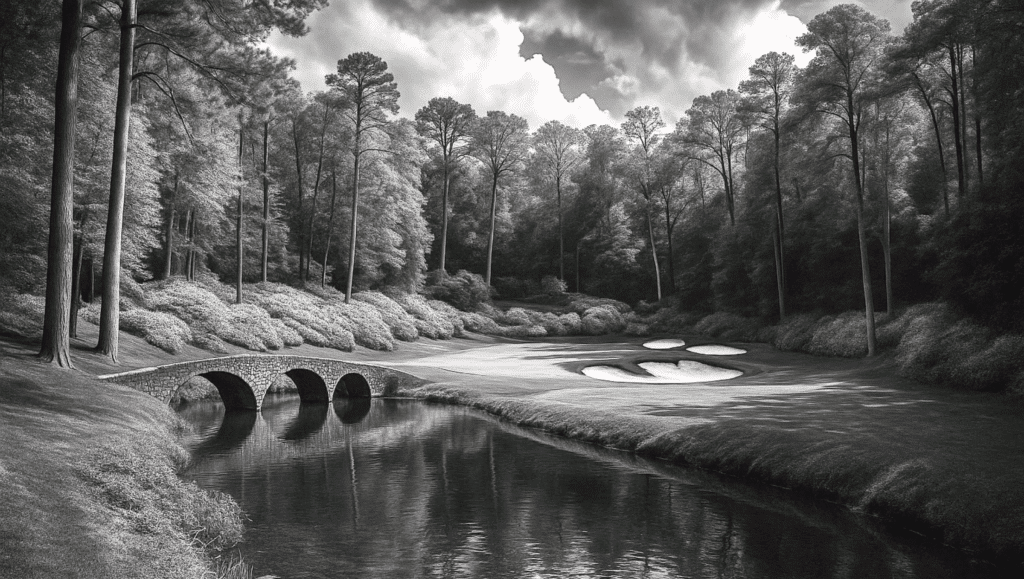If golf has boss levels, these are the final bosses. Here is a countdown of some of the hardest, most terrifying, and most talked about holes on the planet. Each one has a brutal design, a rich history, and the kind of difficulty that can crush even the best players in the world. I will share what makes them so punishing, the stories that made them famous, and what you can expect if you ever get the chance to play them.

Augusta National, Par 3 12th
On the scorecard, it looks simple. Just 150 yards over Rae’s Creek to a shallow green. But the wind swirls unpredictably, often doing the opposite of what it did on the 11th and 13th. Miss short and your ball is wet. Miss long and you will face a wicked chip back toward the creek. This is the nerve center of Amen Corner and the place where tournaments have unraveled. Jordan Spieth made a quadruple bogey here in 2016. For regular golfers, a double bogey is a likely outcome. Playing it at all is nearly impossible since Augusta National remains the most exclusive club in the world. Lucky for all of us, there are plenty of other popular golf courses in Georgia.
Oakmont Country Club, Par 3 8th
One of the longest championship par threes ever used in a U.S. Open, often stretched beyond 250 yards. The green is narrow, crowned, and slick. Misses kick into deep bunkers or thick rough, and two putting is no guarantee. The best golf course in Pennsylvania, Oakmont defines tough golf, and this hole embodies its personality. For the everyday golfer, treating it like a par four is the only sensible approach. Oakmont is private, so an invitation from a member is the only way in.
Bethpage Black, Par 4 10th
Over 500 yards from the back tees, this is a par four that feels like a par five. The tee shot at Bethpage Black demands accuracy through a corridor of rough, and the green is firm and heavily defended. It opens the back nine with punishment that never feels fair. Bogey is a solid score. Double bogey is common even for single-digit handicaps. The good news is that Bethpage is a public course, though demand is sky high. New York residents can play for $65 to $80, while non-residents will pay closer to $150 to $200. The famous warning sign on the first tee lets you know what you are getting into.
Winged Foot West, Par 4 18th
Another of the best golf courses in New York, the 18th at Winged Foot West deserves a mention. Long, uphill, and unforgiving. The tilted fairway makes placement difficult and the green rejects shots like rain off a roof. Go too far right off the tee and you are in the bunker. Miss the approach and you may see your ball roll back down the false front. This is the hole where Phil Mickelson double bogeyed in the 2006 U.S. Open, handing the championship away. If a Hall of Famer made a mess of it, the rest of us have little chance.

Carnoustie, Par 4 18th
The Barry Burn snakes across the fairway and then again in front of the green, waiting to grab golf balls. The wind compounds the difficulty, and the landing zones demand laser accuracy. In 1999, Jean van de Velde stood on this tee with a three shot lead and left with a triple bogey, eventually losing in a playoff. Carnoustie is public, with green fees starting around $300 in off-season. Peak season prices are higher, but so is the chance for slightly kinder weather.
Royal County Down, Par 4 9th
Northern Ireland delivers one of the toughest holes in links golf. The tee shot launches from an elevated box through towering dunes into a narrow fairway. The approach is just as cruel, into a green that tilts toward the sea and hides behind a dune. Add gorse and summer wind, and bogey becomes a respectable result. This course is often ranked among the best in the world. Prices rise in the summer, but the extra cost is worth paying to avoid the worst of the weather.
Kiawah Island Ocean Course, Par 3 17th
Part of the best golf course South Carolina, Kiawah Island’s 17th hole ranks among the toughest ever holes in golf. Water hangs next to a narrow green exposed to Atlantic winds. Miss short or right and you are wet. Miss left, and you are in sand or thick fescue. The 1991 Ryder Cup, dubbed the War by the Shore, saw this hole wreck the scorecards of the world’s best. It was also where Phil Mickelson secured his PGA Championship win in 2021 at the age of 50. Unless you hit the green, a double bogey is waiting. Kiawah is public, but the price is steep at around $500 per round.
TPC Sawgrass, Par 3 17th
On paper, it is a wedge or a nine iron. In reality, it is a wedge into an island. The nerves, the wind, and the history combine to make this one of golf’s most famous short holes. It is where Tiger Woods made his “better than most” putt, and where amateurs like Anthony Spagnolo have set infamous records, including a 66 on this hole alone. The cost to try it yourself is at least $600, and you will want to bring extra balls.

Whistling Straits, Par 3 17th
Lake Michigan guards the left, and rough hillsides guard the right. A pot bunker in front adds insult to injury. This hole was a turning point in multiple PGA Championships and in the 2021 Ryder Cup. Bogey is attainable if you hit the large green, but one mistake can undo your entire round. Public access is available at about $500 per round, with caddies recommended for the best chance at survival.
Pebble Beach, Par 4 8th
Short in length but terrifying in execution. The tee shot leaves you on the edge of a cliff, staring at a second shot over the Pacific Ocean to a small sloping green. Distance control and spin are everything. Jordan Spieth famously risked his life here in 2022, saving par from the cliff’s edge. Pebble Beach is public but expensive, at about $1,000 per round. The history, the views, and the adrenaline make it unforgettable.
Here’s a breakdown of the courses and the countries you’ll need to visit if you want to play them.
| Course | Country |
|---|---|
| Augusta National Golf Club | United States |
| Oakmont Country Club | United States |
| Bethpage Black | United States |
| Winged Foot (West Course) | United States |
| Carnoustie Golf Links | Scotland |
| Royal County Down Golf Club | Northern Ireland |
| Kiawah Island Ocean Course | United States |
| TPC Sawgrass (Stadium Course) | United States |
| Whistling Straits | United States |
| Pebble Beach Golf Links | United States |
These holes are golf’s final bosses. They have turned major championships, crushed the dreams of amateurs, and created some of the game’s most iconic moments. They are also reminders that golf is never just about distance. It is about nerves, precision, and the willingness to take on a challenge that history says you will probably lose.
Clint is PGA-certified and was a Head Teaching Professional at one of Toronto's busiest golf academies. He was also featured on Canada's National Golf TV program, "Score Golf Canada," twice. He graduated with a degree in Golf Management from the College of the Desert in California and studied under Callaway's co-founder, Tony Manzoni. He has a handicap index of 6.2 and spends the winters near Oaxaca, Mexico, where he plays twice a month at the Club de Golf Vista Hermosa. He's written over 100 articles at GolfSpan since 2021. You can connect with Clint at LinkedIn, FB, his website, or Clintcpga@gmail.com.







